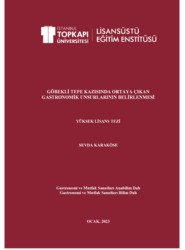Göbekli Tepe kazısında ortaya çıkan gastronomik unsurlarının belirlenmesi
-
Yazar
Sevda Karaköse
-
Tür
Tez
- Yayın Yılı 2024
- Veritabanları TR-Dizin
-
Yayıncı
İstanbul Topkapı Üniversitesi
- Tek Biçim Adres https://hdl.handle.net/20.500.14081/1874
-
Konu Başlıkları
Gastronomi
Göbekli Tepe
Neolitik Dönem
Yemek kültürü
Gastronomy
Neolithic
Period
Food Culture
Bu çalışmanın amacı modern zamanların en önemli arkeolojik keşiflerinden biri olan Göbekli Tepe kazılarında bulunan gastronomik unsurların incelenmesidir. Aynı zamanda bu çalışma kazılarda elde edilen gastronomik unsurların ne amaçla kullanıldığı, günümüzde bölge mutfak kültürünü nasıl etkilediği ve bölge mutfağı ile ilişki durumu gibi alt amaçları içermektedir. Bu amaçlar doğrultusunda nitel araştırma yönteminde sıkça kullanılan veri toplama araçlarından olan görüşme tekniğinden yararlanılmıştır. Görüşme tekniğinin seçilmesinin bir diğer nedeni de çok yönlü gastronomi alanını ve içindeki ortamı anlamak için araştırmacının çalışma alanının içinde olması ve doğal bir ortamda bütüncül ve gerçekçi bir şekilde yaklaşması gerekliliğidir. Araştırma betimsel araştırma modeline uygun olarak gerçekleştirilmiştir. İlk aşamada yapılan alan yazı taramasında “gastronomi” kavramı ve tarihi, Göbekli Tepe bölgesinin tarihi ve özellikleri incelenmiş ardından Neolitik Dönem tarihlenen Göbekli Tepe’nin dönem özellikleri irdelenmiştir. Daha sonra Göbekli Tepe ile ilgili yapılan çalışmaların geniş bir tasnifi yapılmıştır. Çalışmanın ikinci aşaması gözlem ve görüşme tekniği ile bölgeye ziyaretler gerçekleştirilip gerek kazı alanında gerek müzelerde gastronomiye dair unsurlar belirlenip not alınmıştır. Kazıya katılan profesyoneller ve Göbekli Tepe ile ilgili bilgi sahibi olan Şanlıurfa halkı ile görüşmeler gerçekleştirilmiştir. Yapılan bu çalışmalar sonucunda elde edilen bilgilerden hareketle kodlar ve temalar oluşturulmuştur. Yiyecek-içecek unsurları, kullanılan araç-gereçler, mutfak kültürü olmak üzere üç ana tema belirlenmiştir. Yiyecek-içecek unsurları temasına ait tahıl ürünleri, hayvansal ürünler, yağlı tohumlar, içecekler, baklagiller ve bitkiler olarak kodlar çıkarılmıştır. Kullanılan araç gereçlere dair kodlar; havanlar, el taşları, taş kaplar, taş tabaklar, değirmen taşları, öğütme taşı, kesici aletler, baltalar, saklama kapları, tahtadan yapılmış araç gereçler, çakmak taşı, Netherstone (büyük taş kaplar), olarak ayırt edilmiştir. Mutfak kültürü teması özelinde ise tahıl ağırlıklı ve hayvansal gıda ağırlıklı olmak üzere iki kod oluşturulmuştur. Bu çalışma ile Neolitik Dönem yeme-içme kültürünün anlaşılabilmesi için Göbekli Tepe bölgesinde yapılan arkeolojik araştırmalara gastronomi disiplininden araştırmacıların dahil edilmesi ve bölgede gastronomi alanında daha fazla araştırmanın gerçekleştirilmesi gerektiği anlaşılmaktadır. Çalışmanın önemli sonuçlarından biri tarihin sıfır noktası kabul edilen Göbekli Tepe Türk mutfak kültürü için önemli bir kaynak olabileceğidir. Ancak kazı ekibinden gastronomi disiplininden kimsenin olmaması, kazı ekibi başkan veya liderlerin yabancı olması Göbekli Tepe kazılarında gastronomi ile ilgili verilerin toplanmasını zorlaştırmaktadır. Daha fazla bilgi ve belgeye ulaşmak için devlet eli ile yürütülen projelerde gastronomiye dair unsurlarında dahil edilmesi önemlidir. Örneğin Kültür ve Turizm Bakanlığı’nın 2022 yılında başlatmış olduğu “Taş Tepeler” projesine gastronomi alanında araştırmacıların dahil edilmesi önem arz etmektedir.
The aim of this study is to examine the gastronomic elements found in Göbekli Tepe excavations, which is one of the most important archaeological discoveries of modern times. At the same time, this study includes sub-objectives such as what the gastronomic elements obtained in the excavations were used for, how they affect the regional cuisine culture today, and their relationship with the regional cuisine. In order to carry out this study, the interview technique, which is one of the frequently used data collection tools in qualitative research method, was used. Another reason for choosing the interview technique is necessity of researcher to be in the work area and approach it in a holistic and realistic way in a natural environment in order to understand the multifaceted gastronomy field and to understand the environment in it. The research was carried out in accordance with the descriptive research model. In the first stage, the concept and history of “gastronomy”, the history and characteristics of the Göbekli Tepe region and then the period characteristics of Göbekli Tepe in the Neolithic Period were reviewed in the literature. Afterwards, a broad classification of the studies on Göbekli Tepe was made. In the second stage of the study, visits were made to the region by using technique of observation and also interview, and gastronomic elements were determined and noted both in the excavation area and in the museums. Interviews were held with the professionals who participated in the excavation and the people of Şanlıurfa, who were knowledgeable about Göbekli Tepe. Based on the information obtained as a result of these studies, codes and themes were created. Three main themes were determined: food-beverage elements, tools-equipment used, and culinary culture. Codes have been deduced as cereal products, animal products, oil seeds, beverages, legumes and plants belonging to the theme of food-beverage elements. The codes for the tools used are distinguished as mortars, hand stones, stone vessels, stone plates, millstones, grinding stone, cutting tools, axes, storage containers, tools made of wood, flint, Netherstone (large stone vessels). Specific to the theme of culinary culture, two codes were created, mainly grain-based and animal-based food. With this study, it is understood that researchers from the gastronomy discipline should be included in the archaeological researches in the Göbekli Tepe region in order to understand the Neolithic Period eating and drinking culture and more research in the field of gastronomy should be carried out in the region. One of the important results of the study is that Göbekli Tepe, which is accepted as the zero point of history, can be an important source for Turkish culinary culture. However, the fact that there is no one from the gastronomy discipline in the excavation team and the head or leaders of the excavation team are foreign make it difficult to collect gastronomy data in Göbekli Tepe excavations. In order to reach more information and documents, it is important to include elements of gastronomy in government-run projects. For example, it is important to include researchers in the field of gastronomy in the “Stone Hills”
project initiated by the Ministry of Culture and Tourism in 2022.
-
Koleksiyonlar
Lisansüstü Eğitim Enstitüsü

 Tam Metin
Tam Metin

